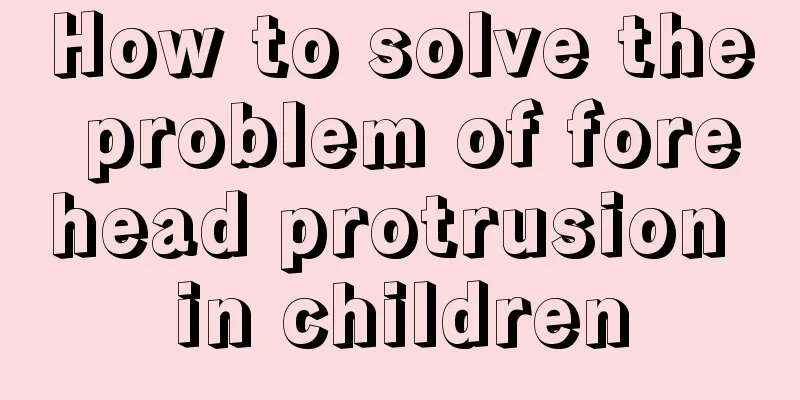What is the reason for thinning hair in babies?

|
Thinning hair is a common problem among adults, and the causative factors vary, most of which are due to stress. However, many people may not think that this problem may also occur in babies. If a newborn baby has sparse hair, it will definitely make people very worried and concerned about the possible causes of the disease. So, what is the reason for thinning hair in babies? Let’s take a closer look at it below. Hair is mainly divided into three layers: epidermis, cortex, and fibroblast: 1. Epidermis It is a transparent, hard, flat cell, like fish scales, covered by 7 to 9 layers of scales, which overlap like tiles on all sides to protect the entire hair. 2. Cortical layer The cortex contains a large amount of melanin, which is also the place that determines the color of hair. Pigment cells begin to grow during infancy until the hair is fully mature. If pigment cells stop growing before they are fully mature, it will lead to the phenomenon of lack of pigmentation or gray hair. In addition, the cortex also has the function of protecting the protein and moisture of the hair, preventing the loss of protein and moisture and causing the hair to dry out. 3. Medullary layer It is composed of transparent polygonal keratinized cells separated from each other and is fibrous. The medulla may be connected or disconnected along with the hair. Hair growth timeline Dermatologists say that every human hair goes through a growth phase, a regression phase, a resting phase, and then starts the cycle over again, continuously. Most of the hair is in the growth phase. During the period between the resting phase and the growth phase, under normal circumstances, the hair will fall out and then grow again. Baby's hair growth schedule When the fetus grows in the uterus to about 20 weeks, not only is its head covered with lanugo, but its entire body is also covered with lanugo. The lanugo feels fine and soft, mainly because there is no medulla in the middle of the hair and the color is very light. Lanugo will turn into velus hair when the baby is born. velus hair is soft and has no medulla in the middle. The difference from lanugo is that velus hair is a little darker in color. The length of velus hair generally rarely exceeds 2 cm. For example, the fine hair on a woman's face or arms is velus hair. Generally speaking, the lanugo on the baby's head will fall off once when the baby is about 7 to 8 months old, and the second time will fall off gradually about 2 to 3 months after birth. Therefore, except for special diseases or premature babies, lanugo can only be seen on the body and face (such as the forehead) of a few newborns. The lanugo on the head will quickly change from lanugo to slightly colored soft hair after birth. Experts say that a newborn's hair will fall out twice during its growth process. The first time is during the fetal period of about 7 to 8 months. The order of shedding is from the forehead to the sides and back of the neck. After the hair in these parts falls out, new hair will continue to grow when the baby is about to be born; the second time of hair loss will be about 2 to 3 months after the baby is born. Some babies only lose hair on the top of the head. However, most babies will start growing new hair after 6 to 7 months of age. The above is an introduction to the reasons why babies have sparse hair. I hope it will be helpful to parents. There are many factors that lead to thinning hair in babies. No matter what the factor is, we must find the cause based on the child's situation. Only when the cause is found can we better solve it. We also need to take good care of the child's hair quality on a daily basis to reduce the chance of hair problems. |
<<: What to do if baby's hair is thin and yellowish
Recommend
What are the symptoms of hernia in children?
I believe that many parents will encounter the pr...
Why do children often sweat?
Many times we are very worried about the physical...
What are the clinical manifestations of craniosynostosis?
Craniosynostosis is a common growth and developme...
What should I do if I get frostbite and red blood streaks when I am a child?
People will have red blood streaks in all seasons...
Can stuttering be cured?
Many symptoms of stuttering are common in childre...
How tall is a one year and nine month old baby?
Parents work hard all their lives just to help th...
What should I do if my six-month-old baby has a fever and diarrhea?
It is common for children to have fever or diarrh...
Why does my child always sleep on his stomach?
Parents who have children will find a problem, th...
Does a child lose teeth at the age of 7?
Do children lose their teeth at the age of 7? Whe...
What should I pay attention to when my baby has megacolon?
The baby is the hope of every family and is worth...
At what age does a child stop wetting the bed?
Bedwetting is a very common phenomenon for childr...
What is the reason for white tongue coating in children?
If a child has a white tongue coating, there may ...
How to treat a child's cold and cough
Children's immunity is weaker than that of ad...
What causes acute pharyngitis in children?
Children are the apple of their parents' eyes...
Six-year-old girl's underwear is always yellow
Women's underwear is closely connected to the...









